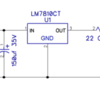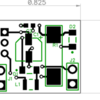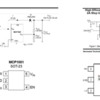Here's another project that I'm toying with. It's a replacement for the Lionel TMCC/Legacy 9V battery with a charger. Since the TMCC/Legacy doesn't have charge capability, normally you use an Alkaline battery and have to swap them with some regularity. This is a replacement that never needs to be change. Since the battery module would get bulky with the charger combined, I'm thinking of two pieces, one is the two flat 5V super-caps and Zener charge balancing diodes, and the other is the charger module that connects to track power. The battery module would have the two batteries sticking out to the side, and be encased in heat-shrink, and the charging circuit will be wired to the battery module.
Since the battery negative goes to frame ground in TMCC, the charging circuit has to be a half-wave affair with frame ground as DC ground as well. The TO220 regulator is on the back side of the board so it can be folded over to minimize the total size of the charging module.
Battery Module
Charging Circuit
Battery Module PCB
Charging Circuit PCB
























